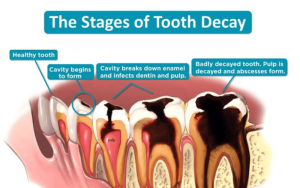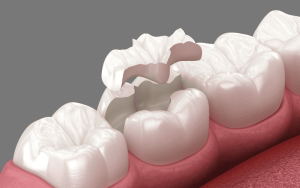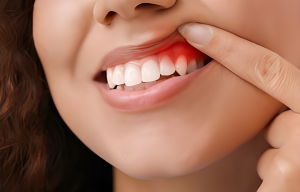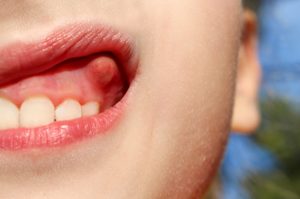Table of content
Teething is an important milestone in a child’s development, so parents pay close attention to it. Many parents feel concerned when they notice that their child is teething in the wrong order. Is this a problem? Will it affect the child’s jaw structure and facial aesthetics in the future? Parents are invited to follow the article to get clear answers to these concerns!
1. How does the teething process occur in children?
At 6 months old, the first baby tooth typically appears, often the lower front teeth. During this time, the child may be fussy, drooling, have swollen gums, and want to chew on objects around them.
Here is the usual teething order in children (*):
- 6 – 10 months: Two lower front teeth.
- 8 – 12 months: Two upper front teeth.
- 9 – 13 months: Two teeth beside the upper front teeth.
- 10 – 16 months: Two teeth beside the lower front teeth.
- 13 – 19 months: First primary molars.
- 17 – 23 months: Upper and lower canine teeth.
- 23 – 33 months: Four second primary molars.
(*) The information above is approximate. Depending on each child’s physical condition, the teething process may vary, but if the child is growing healthy, there is no cause for concern.
So, what does it mean when a child’s teeth grow in the wrong order? This is a phenomenon where teeth appear at the wrong average time. For example, instead of getting two lower front teeth between 6 – 10 months, the child may develop the upper front teeth first.
2. What causes a child to teeth out of order?
There are many reasons that can cause children to teethe out of order, including:
- Genetics: If there is a family member who experienced teeth growing out of order, the child is at a higher risk of facing this issue.
- Strong impact while playing: Any impact during play or exploration can negatively affect the child’s teeth buds, leading to a change in the teething order.
- Infection and gum inflammation: While teething, a child’s teeth and gums are quite sensitive, making them more susceptible to bacterial and viral infections if not properly cleaned. This can cause the child to teethe out of order.
- Inadequate nutrition: An unbalanced diet, especially a lack of essential vitamins like Vitamin D and Calcium, can disrupt the normal teething process.
- Chewing on one side of the gums: The habit of chewing toys on just one side can cause difficulty in teeth emerging at the correct time.

3. Are there any issues if a child’s teeth grow out of order?
Teething out of order can lead to some undesirable effects, such as:
3.1 Child refuses to chew, affecting weaning
Teeth emerging out of order can make the child reluctant to chew and less interested in food due to gum pain and swelling. Over time, this can disrupt the weaning process, causing nutrient deficiencies and stunted growth.
3.2 Permanent teeth growing misaligned
Usually, the primary teeth that emerge first will fall out first, making way for the permanent teeth. If a child’s teeth emerge out of order, it could affect the replacement process and cause permanent teeth to grow misaligned.
3.3 Speech issues
Teething out of order can negatively impact speech. For example, to pronounce the sounds /l/ or /n/, the tip of the tongue must touch the upper front teeth. However, if the upper front teeth haven’t grown yet, and only the lower front teeth are present, the child cannot pronounce these sounds.
3.4 Increased risk of dental diseases
Teething out of order can cause the teeth to crowd and put pressure on other teeth, making it more difficult to clean the teeth properly. Over time, this increases the risk of dental problems like bad breath, cavities in baby teeth, and gum disease…
4. What should parents do if their child’s teeth grow out of order?
The best solution for a child’s teeth growing out of order is for parents to take the child to a dentist for a thorough examination and receive the appropriate advice for handling the situation. Additionally, parents should ensure they choose a reputable dental clinic and skilled doctors to closely monitor the child’s teething and tooth replacement process, in order to correct any undesirable misalignments promptly.

For 12 years, Elite Dental has been chosen by many parents as a reputable pediatric dental center, with the following highlights:
- Experienced doctors: Elite Dental is proud to be the “home of top experts” in the dental field, with a team of specialists who have extensive experience in pediatric dentistry and understand children’s psychology. We ensure to provide accurate, detailed consultations and offer the most effective solutions. For misaligned teeth or signs of overbite, the doctor will develop a early orthodontic treatment plan using safe methods to quickly adjust the teeth position and bite.
- Modern equipment: In addition to skilled doctors, Elite Dental owns modern equipment to support examinations and treatments, ensuring high and sustainable results, such as Sirona X-ray machines and Trios Scanners…
- Affordable, transparent pricing: All examination and treatment costs for pediatric dentistry are clearly communicated during consultations, with no additional hidden fees during treatment.
- Children’s play area: The clinic also has a colorful play area designed to create the most comfortable atmosphere for children visiting the dental office.
Additionally, parents should take care of their child’s oral hygiene carefully using the following methods:
4.1. Pay attention to thorough oral hygiene
Since children cannot take care of their oral hygiene effectively on their own, parents play a crucial role. To best protect your child’s teeth, parents should:
- Use gauze to clean the tongue, gums, and baby teeth with warm water or saline after feeding.
- When the child turns 2, parents can use a soft toothbrush with a sugar-free toothpaste containing Xylitol and Active Fluoride to whiten teeth, eliminate bad breath, and kill bacteria effectively.
- At age 3, encourage the child to brush their teeth at least twice a day, along with flossing to clean between the teeth.
- Every 3 months, parents should replace the child’s toothbrush.
4.2. Ensure adequate nutrition for the child
Another solution to address misaligned teething is to create a healthy diet, providing all four essential nutrient groups (carbohydrates, proteins, fats, vitamins, and minerals), along with supplementing Calcium, Fluoride, and Vitamin D. Parents can consider foods beneficial for the child’s teething process, such as avocados, cheese, milk, meat, seafood, and fresh fruits.
4.3. Limit sugary foods and carbonated drinks
Most sugary foods (like cakes, candies…) and carbonated drinks are not good for tooth enamel. Therefore, to protect your child’s oral health, parents should reduce the consumption of sweets and carbonated drinks, replacing them with “healthy sweets” like fresh fruits, yogurt, and nuts.
5. Frequently Asked Questions
Regarding the issue of children teething out of order, here are some other common concerns:
5.1. Is it a problem if the child’s upper/lower teeth appear first?
The teething order and speed vary for each child depending on their physical characteristics. The key is for parents to closely monitor the child’s teething process so they can properly care for the child’s teeth and seek timely advice from a doctor to handle situations where teeth emerge out of order.
5.2. Do misaligned baby teeth affect the child?
Although baby teeth can be replaced by permanent teeth later, misaligned baby teeth can cause cavities, gum disease, and impact chewing. More dangerously, the process of permanent teeth emerging may be interrupted, causing misalignment following the baby teeth, leading to conditions such as overbite, deep bite…
5.3. Why should children undergo orthodontic screening at 6 – 7 years old?
Doctors recommend that parents take their child for orthodontic screening at 6-7 years old. This screening helps assess the condition of the child’s jaw, tooth buds, and teething trends. Early detection of dental issues related to the jaw, permanent teeth, and bite allows for timely corrective treatment, providing a beautiful, confident smile with the fastest results and the most cost-effective solutions.
Hope the above information has helped parents understand the issue of children teething out of order. At the same time, parents are provided with the most appropriate solutions to avoid affecting their child’s ability to chew, jaw structure, and facial aesthetics.






